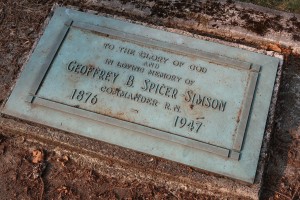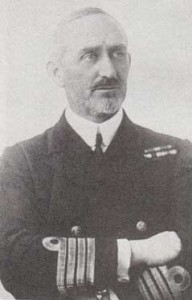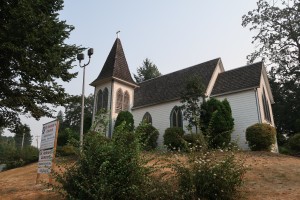Sayer’s Tea Shop
Codfish, Mackerel, Mimi and Toutou
Rose Allnut turned the sign on the shop door one last time.
Sayer’s Tea Shop served her and Charlie well since coming to Courtenay two decades plus three ago. As Charlie’s machines spun for the last time, he wiped his brow and back of neck. Now one last evening to sit amongst the teas, cakes, trifles…[cucumber sandwiches]…and friends.
Dundee, Ginger-Walnut, Buttercup, Chocolate and Pear Charlotte…scones and clotted cream…the finest in jellies and jams; while from the far back the metal turnings of a final day’s work dripped in the sweet smell of machine oils mixed with hot metals, and steam. As the belts slackened – one final blast from the steam whistle. Charlie pulled the cord, it was a familiar sound for all.
Charlie washed in the large, chipped, granite-ware bowl and came through the draped door passage, turning towards the chair where he could best watch his whirling and spinning amusements. They gave Charlie and Rose, as well as the families who stopped by great fun, especially at Christmas time, when children sat amongst the plates of biscuits chewing and sipping cocoa as the machines provided endless wonder. It was Christmas Eve.
Here too at Sayer’s Tea Shop, Charlie and Geoffrey passed their evenings speaking of their days, Rose’s too, in Africa. Their adventures similar – boats, a journey, a lake, an opponent. Heat and adventure, a distant land, where brother and brother-in-law, Reverend Samuel Sayer, remained within the ground of August 1915.
There was a bold fisherman who sailed out of Pimlico, Charlie would sing and as his chorus slipped to the evening Rose, Geoffrey, occasionally Amy, and Charlie would laugh. Animals and insects, reptiles and leeches, Königin Luise, Kingani, Hedwig von Wissmann…all were familiar.
Unlike their Royal Navy friend, Geoffrey Spicer-Simson DSO, Rose and Charlie were civilians during their Great War in Africa managing to escape the continent for safer shores in Malta. In the dockyards Charlie worked machining parts, small and large, for the engines of the Royal Navy, while Rose joined the Patriotic Society in Valletta, raising funds, writing letters for wounded soldiers, and producing bandages from well-laundered linen bed sheets. Both were well-known.
Home, for a time, was nearby at Floriana but in 1919 they came…for Charlie…back to Canada…to Middleton…Saskatoon…Courtenay. But there remained a desire for one last visit to Rose’s England, Floriana and their East Africa. Wherever Rose and Charlie went friends remained.
As young eyes closed in Sayer’s Tea Shop to a Christmas sleep, grateful families left with their precious bundles and the Captain rose…They would meet again and as the door closed behind Spicer-Simson, the door’s bell jingled, an angel took flight, and Geoffrey heard one last time…There was a bold fisherman who sailed out of Pimlico.
———-0———-
Today we have had some fun for Christmas – mixing classic film fiction with “Based on a True Story”.
Charlie and Rose Allnut are characters from C.S. Forrester’s The African Queen (1935) and released in 1951 as a major motion picture starring Humphrey Bogart and Katherine Hepburn. The novel and film differ. In the film, Charlie Allnut is a Canadian, not a Cockney Englishman…I wanted him to come back to Canada, together with his Rose. As well, watching Charlie and Rose (Bogart and Hepburn) I wanted to know what became of them…where did their lives take them? In the novel Forrester’s narrator records, Whether or not they lived happily ever after is not easily decided.
For some years I wanted to bring Charlie and Rose together with a real-life African adventurer…today this is done…bringing together the Allnuts with Geoffrey Spicer-Simson DSO, who commanded the Lake Tanganyika Expedition, the Mimi and the Toutou, and who moved to Courtenay, B.C. in 1937. As a historian and researcher I was always interested that Spicer-Simson became involved in the local historical society. Geoffrey Spicer-Simson died in 1947 and is buried in St. Andrew’s Anglican Church Cemetery, Sandwick, just outside of Courtenay on Vancouver Island.

Geoffrey Spicer-Simson’s marker at St. Andrew’s Anglican Church Cemetery. His wife, Amy Elizabeth Spicer-Simson is next to him.
(P. Ferguson image, August, 2017)
The second line of the Allnut/Bogart song, includes codfish and mackerel. The four words together, in the subtitle, Codfish, Mackerel, Mimi and Toutou, are a deliberate odd choice adding curiosity and a “where is this going?” portion for this year’s Christmas story. Knowing of Spicer-Simson’s eccentricities I hope he might have approved. Incidentally Spicer-Simson originally wanted to name his vessels Cat and Dog. I can hear them all laughing now.

Geoffrey Spicer-Simson D.S.O. After service in China, during the Boxer Rebellion, he came to Victoria, B.C. and in 1902 married Amy Elizabeth Baynes-Reed.
(Wiki Commons image)
And so at this time of year…hopes for a jolly Christmas Eve and Christmas Day…may your world bring sunshine and joy…to you and yours…for all time…and time for all.



Comments